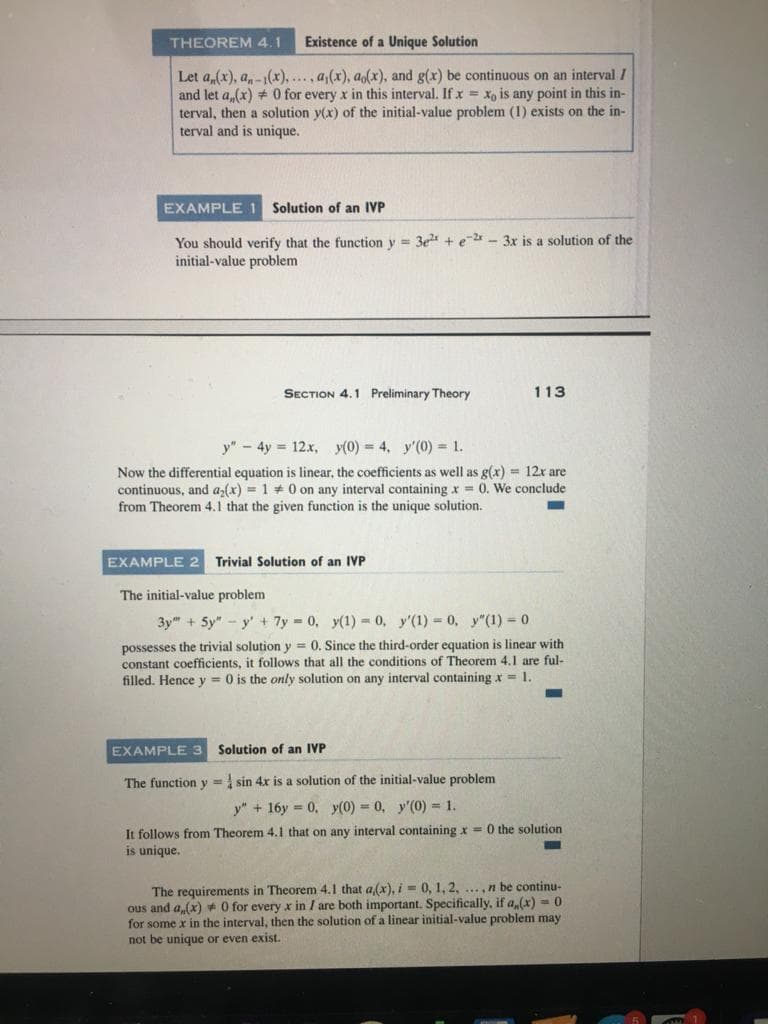Solution and
Advanced Engineering Mathematics
10th Edition
ISBN:9780470458365
Author:Erwin Kreyszig
Publisher:Erwin Kreyszig
Chapter2: Second-order Linear Odes
Section: Chapter Questions
Problem 1RQ
Related questions
Question
Differential Equations HW problem. Solution and work needed, please. I have attached a picture of the section 4.1 theorem from my textbook as well. However, you can refer to the textbook if needed. It is called "A first course in differential equations the classic 5th edition" by Dennis Zill.

Transcribed Image Text:Consider the second-order, linear, homogeneous differential equation with
initial conditions,
x²y" +xy - 4y = 0
y(0) = 0
y'(0) = 0
This initial value problem has many solutions, for instance y1 = x2 and y2 = 0. Does
this violate the existence and uniqueness theorem for linear differential equations, from
section 4.1? Explain.

Transcribed Image Text:THEOREM4.1
Existence of a Unique Solution
Let a,(x), a-1(x),.., a (x), a(x), and g(x) be continuous on an interval /
and let a,(x) + 0 for every x in this interval. If x = xo is any point in this in-
terval, then a solution y(x) of the initial-value problem (1) exists on the in-
terval and is unique.
EXAMPLE 1 Solution of an IVP
You should verify that the function y = 3e + e 2
initial-value problem
3x is a solution of the
SECTION 4.1 Preliminary Theory
113
y" - 4y = 12x, y(0) = 4, y'(0) = 1.
Now the differential equation is linear, the coefficients as well as g(x) = 12x are
continuous, and a(x) = 1+ 0 on any interval containing x = 0. We conclude
from Theorem 4.1 that the given function is the unique solution.
EXAMPLE 2
Trivial Solution of an IVP
The initial-value problem
3y" + 5y" - y' + 7y = 0, y(1) -0, y'(1) = 0, y"(1) = 0
possesses the trivial solution y = 0. Since the third-order equation is linear with
constant coefficients, it follows that all the conditions of Theorem 4.1 are ful-
filled. Hence y = 0 is the only solution on any interval containing x = 1.
EXAMPLE 3 Solution of an IVP
The function y = sin 4x is a solution of the initial-value problem
y" + 16y = 0, y(0) = 0, y'(0) = 1.
It follows from Theorem 4.1 that on any interval containing x = 0 the solution
is unique.
The requirements in Theorem 4.1 that a,(x), i = 0, 1, 2, ..., n be continu-
ous and a,(x) + O for every x in / are both important. Specifically, if a,(x) = 0
for some x in the interval, then the solution of a linear initial-value problem may
not be unique or even exist.
Expert Solution
This question has been solved!
Explore an expertly crafted, step-by-step solution for a thorough understanding of key concepts.
This is a popular solution!
Trending now
This is a popular solution!
Step by step
Solved in 2 steps with 2 images

Knowledge Booster
Learn more about
Need a deep-dive on the concept behind this application? Look no further. Learn more about this topic, advanced-math and related others by exploring similar questions and additional content below.Recommended textbooks for you

Advanced Engineering Mathematics
Advanced Math
ISBN:
9780470458365
Author:
Erwin Kreyszig
Publisher:
Wiley, John & Sons, Incorporated

Numerical Methods for Engineers
Advanced Math
ISBN:
9780073397924
Author:
Steven C. Chapra Dr., Raymond P. Canale
Publisher:
McGraw-Hill Education

Introductory Mathematics for Engineering Applicat…
Advanced Math
ISBN:
9781118141809
Author:
Nathan Klingbeil
Publisher:
WILEY

Advanced Engineering Mathematics
Advanced Math
ISBN:
9780470458365
Author:
Erwin Kreyszig
Publisher:
Wiley, John & Sons, Incorporated

Numerical Methods for Engineers
Advanced Math
ISBN:
9780073397924
Author:
Steven C. Chapra Dr., Raymond P. Canale
Publisher:
McGraw-Hill Education

Introductory Mathematics for Engineering Applicat…
Advanced Math
ISBN:
9781118141809
Author:
Nathan Klingbeil
Publisher:
WILEY

Mathematics For Machine Technology
Advanced Math
ISBN:
9781337798310
Author:
Peterson, John.
Publisher:
Cengage Learning,

